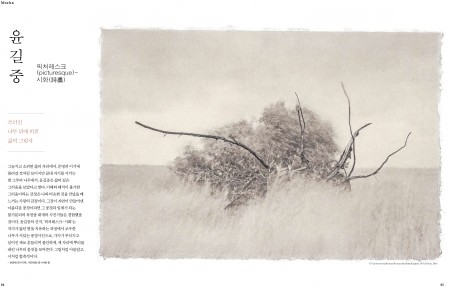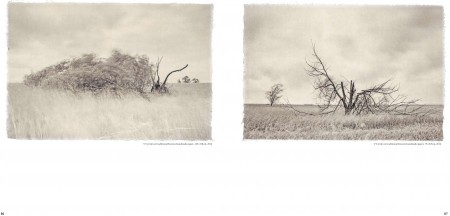TEXT-Picturesque-Poem/ Picture
Picturesque-Poem/ Picture
Shadow of Life on a Fallen Tree
Kim So Yoon
Yoon Gil Jung found a deep longing of life from a shaded, isolated life and a tree which protects itself in a storm of modern convenience. The feeling, longing, which is impossible to understand or interpret, is a kind of love when a person meets in an existence that is similar to oneself. If that existence is a beautiful landscape, most photographers would experience the eagerness of the united wholeness between him/herself and nature. Yoon Gil Jung’s new series, Picturesque-Poem/ Picture, which was made during the artist’s recovery from his illness, is a landscape of trees that are broken and fallen but still living their lives. They are beautiful like paintings and implicative like poems.
Choi Yeon Ha (curator, photo critic)
Yoon Gil Jung’s perspective is warm toward the severely wounded trees that are still living. Yoon found himself living in endless competitions through those trees that are grounded and revealing their roots. Their acceptance of collapse and adaptation to a new life gave a resonance of hope to the photographer who used to think that a failed competition is the end of world.
Yoon Gil Jung’s new series, Picturesque-Poem/ Picture has consistency with his previous works about the disabled life. He is looking at the “disability” of fallen trees and he is planning on working with various object based with the same theme.
Gallery Now exhibits Yoon’s solo show, Picturesque-Poem/ Picture in May 7- May 13. The undertone and texture of the traditional Korean rice paper enforces the depth of Yoon’s tree images. Daegu Culture& Art Center, Daegu Art Festival 2014, also exhibits the same show in May 28-June 1.
Q: What was the reason taking pictures of trees?
A: This series began 3 years ago. Initially, I drove around the country and photographed trees in solitude. While I was interested in trees, I read a book and took lectures of Kim Yong Gyu who was an expert of forest. Competing ,but still sharing for life is quite similar between trees and human beings. When I understood this, I wanted to create works of trees relating humans. Once a tree is rooted in a certain environment, that becomes an inevitable fate, and then the tree should improve its lot. If a seed is located underneath a big tree, the seed will grow easily for a while because of the fertile soil, but the tree either dies or grows to the opposite side of a big tree. Reflecting this to human life, people who come from a rich family grow up without hardship, but if they do not maintain their lives properly, they could easily collapsed suddenly. Trees and human beings are quite similar like this. Since Shihwaho, where Picturesque-Poem/ Picture was created, is a marsh with soft soil, lots of trees grow well until a certain point and then many of them fall. How interesting it is when we reflect our lives to these huge trees that could collapsed at any moment.
Q: Your previous images of tree was quite different. Why did you change your focus to damaged trees in Picturesque-Poem/ Picture?
A: My previous works were focused on the straight beauty of trees and their background. They were very popular hence being sold out in my exhibition, however I was wondering if I was repeating myself. It looked beautiful but was a lack of meaning for me. I worked Picturesque-Poem/ Picture around the same time I worked at the school for handicapped. The experience with disabilities changed my attitude toward life. I began to focus on the weak and neglected, and the collapsed trees were one of them. Observing those trees, I realized that trees are not that different from human society. I have worked almost 30 years in industries and lived in endless competitions. I used to believe that a fail in competition would be the end of my life. Through the observation of fallen trees that live their lives in different ways in a crisis, I realized a different hope for my life, a better life. That was what I wanted to express in the Picturesque-Poem/ Picture.
Q: Were all photographs taken in one location?
A: The location is an unknown swamp close to Hyeongdo, not too far from Wooeumdo in Gyeonggido Hwaseong. I visited the swamp 31 times for a year. One day, I took a different route than usual and accidentally found an obliquely standing tree on the field. In order to take pictures in close distance from that tree, I crossed a 3 meter stream with my rain boots and then I found many others all over the swamp. I took a detour around a mountain after the photo shooting because the original route was flooded. Then, I found more interesting trees. Ever since that day, I often went there for photo shooting.
Q: It seems like that this series means a lot to you.
A: I gradually developed empathy with trees. I even said hello to them like an insane person. Since I wanted to express trees and wind in my photographs, I always took pictures on rainy and windy days. I always wore a rain coat, rain boots, and a heavy backpack for every photo shooting. I even made a special lens cover to protect my lens from rain. This is the first time in my life to voluntarily cling on something this much. During the photo shooting, I witnessed a collapsed tree from heavy wind and that incident made me think about my future. I thought that I was looking at my future. At one point, I realized that the collapse could be the end of life but it also could be a beginning of a different life. After I realized that, my attitude towards life became more sincere.
Q: The traditional Korean handmade paper you used has unique texture and color tone. How is it different than regular photo paper?
A: There is a big difference for an image on a regular paper and traditional Korean handmade paper. I was attracted by the mysterious depth of rice paper, so I wanted to print the Korean landscape on Korean traditional handmade paper. Most rice papers on the market are either machine-made or imported with the mixture of Mulberry and wood pulp. The traditional Korean rice paper is hand-made only with Korean Mulberry and master craftsmen graft4 layers in order to prevent ink spread. I have studied the history of traditional Korean handmade paper and visited Yeoju where the traditional paper is created. There is a difference in preservation force between the common rice paper and the traditional one. Kim Hong-Do’s 1300 year old paintings or old documents on faded rice paper are still well preserved because the rice paper was made with the traditional unicycle knitting technique.
Q: Is there any other work that you are planning?
A: I want to make works related to “disability”. Fallen trees can be understood in this way. Taking photographs of disabled people affect a lot to the tree series. For future work, I want to make images of their domestic lives.
Q: You have another job other than being a photographer. What is photography to you?
A: I used to dream of being a writer until high school. It might be stereotyped, but over 30 years, I have worked something that I did not really enjoy because I was the first son in the family and felt responsibility for my family. Even when I was only thinking about survival in competitions unfulfilled, something inside of me was willing. Now, I want to make my dream come true through photography. I feel that my suppressed passion has spewed all at once, I am happy. Looking at a flower and a clump of grass, I sincerely contemplate about life. While I worked with trees in Picturesque-Poem/ Picture my sincerity was emphasized . I now truly live my life.
Yoon Gil Jung majored in management Kyungpook National University. His solo exhibition Picturesque-Poem/ Picture is at the Gallery Now, May 2014. Yoon also exhibited Dream of Yellow-Field, a series of disabled students in Nodule Disabled School at a gallery in Hyehwa Station, 2013. Including 3 people show, I am not a lame at Jung-Dong Gallery, 2012, Yoon exhibited many other exhibitions.


